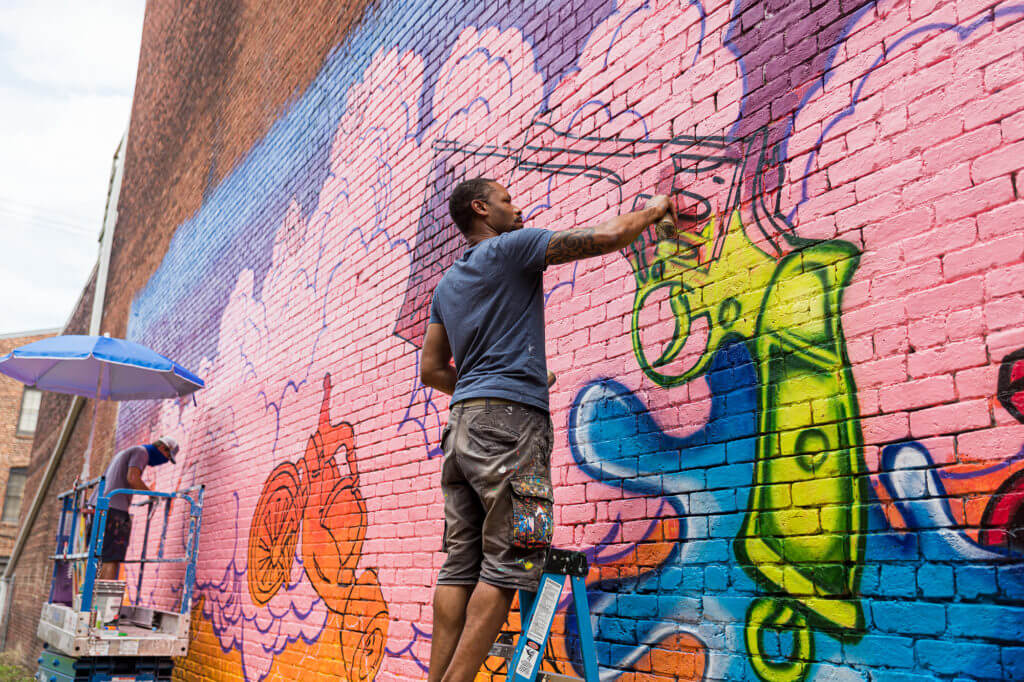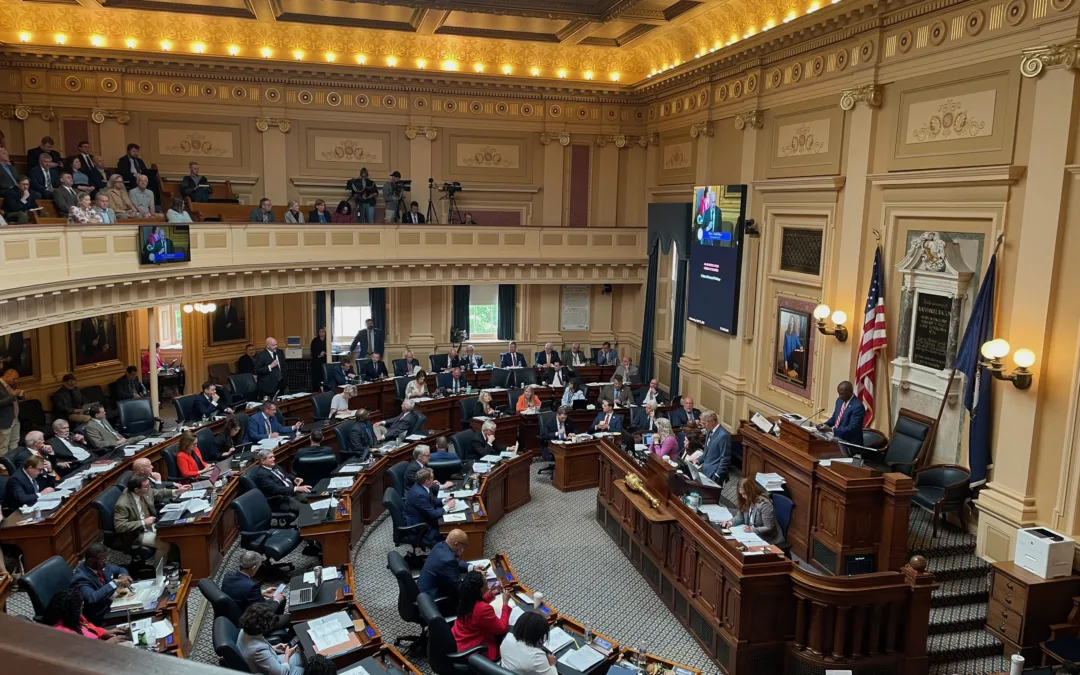
Hamilton Glass and Matt Lively paint, “In Conversation,” a Richmond mural with the Mending Walls project. Photo courtesy of Katrina Boone.
Artists want to spark dialogue and “Mend Walls” through a collaborative art project
RICHMOND-As Confederate statues fall, new creations rise up to document a historic moment. In the streets of Richmond, long known for monuments and murals, a collaborative public art initiative is “Mending Walls.” Local creative Hamilton Glass launched the project this summer, bringing artists from different backgrounds to collaborate and engage in racial justice dialogue. Mending Walls artists are painting at least 17 murals around the city, and they participate in podcasts and virtual gatherings to discuss their backgrounds and experiences.
There are already more than 100 murals in the state capital, and events like the RVA Street Art Festival and Richmond Mural Project renew the collection annually. Richmond was also the capital of the Confederacy, home to numerous related monuments. In recent months, government orders took down some, protesters others. Four out of the five Confederate monuments of Monument Avenue are gone, while controversy persists around the removal of a 12-ton, 60-foot-high representation of Robert E. Lee.
During a summer of protests in Richmond, #BlackLivesMatter, #DefundPolice and related messages and imagery covered the statues and their pedestals. Black Richmonders now gather on the monuments’ grounds, often for the first time; Black drummers and dancers reclaim space; and locals rename areas for victims of police violence. In a sense, the Mending Walls mural project captures some of the spirit and force of the ephemeral creations made in the heat of protest and translates them into the world of sanctioned murals, which have a somewhat longer shelf-life. In Mending Walls’ first virtual community conversation on Sept. 16, Glass described protest tags as “unheard voices… Instead of power washing over them, we need to amplify [them].”
When Artists Converse and Collaborate
Creating street art during a pandemic is a little different. Mending Walls requires anyone who takes part in a project to wear a face mask. Small businesses or property owners donate walls to the project. Glass tells Dogwood one challenging aspect of the process, both for himself as a director and the wall owners, is that Mending Walls does not dictate what each pair of artists will discuss or paint. He calls this approach “unprecedented.”
Glass himself co-created a mural for Mending Walls called “In Conversation,” with artist Matt Lively, whom he previously knew. The wall on Broad Street depicts a collage of childhood imagery and captures the memories that arose when two painters of different races and backgrounds discussed their youths. Glass, who is Black and grew up in Philadelphia, learned that toy guns could put Black youth in real danger with police. Lively, who is white and from the suburban Southside of Richmond, recalled the now-illegal lawn dart of 80s lore. One cooled off in fire hydrants, the other in yard sprinklers.

A look at “In Conversation,” a mural in Richmond by Hamilton Glass and Matt Lively with the Mending Walls project. Photo courtesy of Katrina Boone.
Glass says talking with Lively about their pasts, the murder of George Floyd and other related topics increased understanding and empathy between them. Lively says talking with Glass helped him to develop more empathy, as well, especially as their conversations continued throughout the mural creation.
“Being on a wall for a week, painting an image already worked out, provides the chance to relax and really listen without the need for a quick, habitual retort,” Lively said.
Richmond Art Creates a Conversation
Artists Nico Cathcart and Austin Miles paired up to paint two murals for this series, including, “A Time to Rise,” which they created in partnership with Richmond’s 17th Street Market. Against a backdrop of BLM graffiti, it shows a Black mother and child astride a leaping horse, an image that echoes and replaces Richmond’s traditional imagery of mounted Confederate leaders. Cathcart says a protest sign the artists saw that read, “George Floyd invoked all mothers when he cried for his,” served as one of the inspirations for this piece. This mural is painted on wood and can move to different locations — the Virginia Museum of History and Culture recently exhibited this work.
This street art portrayal of Black people on horseback calls to mind a recent acquisition nearby at the Virginia Museum of Fine Arts (VMFA): “Rumors of War” by Kehinde Wiley, who painted President Obama’s official portrait and often depicts Black people in pieces that reimagine classical European genres. Wiley created the 2019 work, a bronze statue of a contemporary Black man on a horse, as a direct response to Richmond’s Confederate monuments.
Cathcart sees surface parallels as well as several differences between their mural and Wiley’s monument — she says, “We were pulling these images from the same sets of statues at different times. Kehinde’s amazing piece is a call to action. Ours is in the middle of it; born of the social revolution that we are seeing here in the city and [country].” Other Mending Walls murals feature clenched fists, a portrait of local rapper Radio Blitz with the names of Black victims of police violence, children holding hands, African Adinkra and Akan symbols, the family totem pole of one of the artists, and more.

Nico Cathcart and Austin Miles produced “A Time to Rise.” The Richmond mural is part of the Mending Walls Project. Photo courtesy of Mending Walls.
Using Street Art to Cultivate Dialogue
Mending Walls’ sponsors include the Community Foundation for a Greater Richmond and Altria, and it partners with the Drums No Guns Foundation and community activists, among others. And the initiative runs a GoFundMe.
Apart from this mural project, there are additional new artworks in Richmond that center racial justice protests. For example, local artists revised the Broad Street “Greetings from Richmond” mural, a popular selfie spot, so that police in riot gear and protesters with BLM signs replaced famous landmarks. The city’s Public Art Commission recently approved a massive Black Lives Matter road painting, like those seen in New York City and D.C., which Glass advocated for.
Glass says, while the project “is far from over,” the initial community reception has been great so far. More than half of the murals are complete at the time of this article. Glass says finishing the art is just the beginning — he likens it to “candy” that can entice and engage people. Just as the creation of the mural, “In Conversation,” cultivated greater empathy between two painters, Glass envisions the Mending Walls project doing the same thing on a larger scale.
To spur community dialogue, Mending Walls runs a podcast and, this week, it launched virtual public conversations with participating artists. Glass says the deeper purpose of the project is “to connect people and get people to have a little bit more understanding about people’s backgrounds [and] the way people are conditioned… we’re not going to have any change in our society until we have some empathy around everyone’s experience.”
Politics

Youngkin, Democrats to start over on budget talks
The Republican governor stood with Democratic leaders in the General Assembly on Wednesday in a bid to ease tensions over their budget debate....

VIDEO: Domestic abuse victims speak out against the gun law bills Gov. Glenn Youngkin vetoed
Senate Bill 47 and House Bill 46 aim to close the loophole that allows offenders to transfer their firearms to someone else instead of relinquishing...
Local News

Virginia verses: Celebrating 5 poetic icons for National Poetry Month
There’s no shortage of great writers when it comes to our commonwealth. From the haunting verses of Edgar Allan Poe, who found solace in Richmond's...

Join the fun: Recapping Family Literacy Night’s storybook adventures
When’s the last time you read a book aloud with a loved one? If it’s difficult to answer that question, then maybe it’s time to dust off that TBR...




